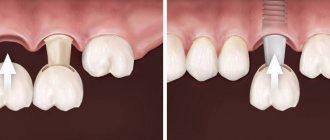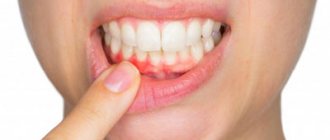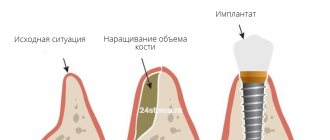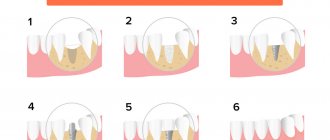- What is atrophy
- Types of atrophy
- Osteoplasty
- Implantation methods
- Alternative Methods
- Prices
- Work examples
- Doctors
- Reviews
Bone atrophy is the process of cell destruction due to disruption of tissue nutrition. The process can be stimulated by tooth loss, gum disease, endocrine diseases, infections, and the age factor. Implantation with a lack of tissue is difficult: there is no way to correctly position and fix the implant. Implantation is carried out using the classical method (with mandatory preliminary osteoplasty) or according to the protocol with immediate loading (bone grafting is indicated only in conditions of severe atrophy).
- When used:
missing 1 or more teeth due to bone deficiency - Type of anesthesia:
local anesthesia - Procedure time:
from 15 minutes - Treatment period:
up to 4 months - Healing period:
up to 7 days - Age restrictions:
from 18 years old
What is bone atrophy
Bone atrophy, or loss, is a result of tooth loss. Due to uneven load, the jaw loses volume - in the first year, tissue loss is 25%.
Atrophy can be stimulated by gum disease, endocrine, infectious diseases and the age factor. In patients, the blood supply to the jaw deteriorates, there is a lack of oxygen - the pressure on the tissue changes. The central or spongy layer, which has a porous structure, is subject to the process.
Jaw deformation has different intensity:
- I degree.
The blood supply is not impaired. It is possible to install a classic implant. - II degree.
The mucous membrane contracts. The operation is performed after plastic surgery. - III degree.
The contour is smoothed from the chin and in the oral cavity. Bone augmentation is a must.
The results of the deficiency are expressed in deterioration of speech, changes in facial proportions, and the appearance of wrinkles in the oral area. An advanced degree of atrophy causes displacement of the dentition, loss of adjacent or opposite units. Classical implantation is not possible with bone atrophy.
What does an increase in temperature indicate?
A low-grade or febrile temperature reaction that occurs after surgery is a rather unfavorable sign indicating the occurrence of an inflammatory process. Fever after bone grafting and sinus lifting can be caused by the following factors:
- Infection of a postoperative wound by contact (bacteria from the oral cavity cause inflammation);
- Infection of the maxillary sinus (infection spreads due to perforation of the mucous membrane into the sinus cavity);
- Infection of osteoplastic material (pathogenic microorganisms can penetrate both from the oral cavity and from the maxillary sinus in the presence of chronic sinusitis).
The severity of the febrile syndrome and some other indirect signs make it possible to roughly suspect the origin of the inflammatory process, but in most cases opportunistic and pathogenic strains of staphylococci multiply in the oral cavity.
According to these data, treatment is being developed for complications of surgical intervention, which should not arise at all at the present stage of development of dentistry.
The inflammatory process in the oral cavity leads to an increase in temperature, both systemic and local. The fever in such people, as a rule, does not even reach 38 degrees, but in rare cases exceptions are possible. Contrary to the opinions of uninformed people, such a condition as a decrease in the body’s defenses (especially if we are talking about immunodeficiency) does not lead to a worsening of fever, but on the contrary, it reduces it to a minimum. And this reduced reactivity of the immune system only increases the risk of an unfavorable outcome, since patients do not immediately detect the presence of inflammation.
Types of bone atrophy in the upper and lower jaw
Destruction of the bone structure of the upper jaw is fraught with injury to the closely localized maxillary sinus. The cells in this area have a loose structure, the bone is thinner, and is actively resorbed in the area of the masticatory elements. When fixing long implants, there is a risk of injury to the sinus membrane, which can stimulate its rupture and the development of sinusitis or chronic runny nose.
The Schroeder classification identifies three types of atrophy of the upper jaws
:
- The jaw tubercles are pronounced, physical abnormalities are not visible, the mucosa is noticeably curved, the palate is deep. Implantation is possible without complications.
- The alveolar processes are not clearly expressed, the palate is of medium depth. Installing implants using the classical method is doubtful, but using a one-stage method is possible.
- The cells are seriously atrophied, the alveolar processes are smooth, the palate is flat, the fold at the level of the palate does not hold its shape. Fixation of classical implants is not possible; it can be done in one stage, depending on the location of the defect.
The tissue of the lower jaw is dense from below and does not decrease so rapidly, but as atrophy progresses, the dentist is faced with the problem of the nearby localized mandibular nerve (it is located under the roots of natural elements). Nerve injury can cause complete or partial loss of sensation in the lower facial part.
According to Keller, there are four types of mandibular atrophy
:
- The tubercles of the alveoli are visible on the jaw, a fold of the mucous membrane is noticeable. You can install classic or one-stage implants.
- The ridge becomes sharper, and muscles are attached at its base. Installation of a classic implant may cause discomfort, but a one-stage implant does not cause complications.
- The jaw of patients with early removed lateral teeth - the alveoli are thinned, the volume in the center does not decrease. It is not possible to implant classical artificial roots; one-stage ones are possible, but there is a fear of the implant shifting when chewing food in case of a single defect.
- In the area of the frontal incisors, the bone is clearly atrophied; the lateral row is not affected. Implantation for such bone tissue atrophy is possible using a combined method.
How to avoid fever after a sinus lift?
Adverse outcomes after bone grafting and sinus lifting, among other things, arise due to several factors:
- Insufficient examination of the patient at the preparatory stage (the doctor does not identify some contraindications to surgical intervention, for example, oral infections or the presence of immunodeficiency);
- Poor preparation of the patient for surgical procedures (many clinics require professional teeth cleaning before bone grafting);
- Dentist mistakes during the sinus lifting process (perforation of the maxillary sinus or infection with low-quality instruments or consumables);
- Failure to comply with recommendations during the rehabilitation period (refusal to take necessary medications, improper treatment of the oral cavity, and so on).
In the vast majority of cases, the occurrence of fever after sinus lifting and bone grafting is the result of the patient’s carelessness or dishonesty. You can avoid the problem in a simple way: adhere to the necessary rules. These include:
- Completing all prescribed tests to detect health problems (mostly this includes laboratory tests of blood, urine and x-rays of the maxillary sinuses);
- Taking antibacterial drugs for 5-7 days after surgery to prevent infection (as a rule, broad-spectrum drugs are used);
- Treating the oral cavity with an antiseptic solution (rinsing is not allowed, but blotting the wound surface with a moistened cotton wool minimizes the risk of infection);
- Thorough brushing of teeth after each meal (removing food residues will remove an environment suitable for pathogenic microorganisms);
- Control visits to the dentist according to a pre-agreed schedule (the doctor monitors the implantation of the graft, assesses the condition of the postoperative wound and changes recommendations depending on objective data).
By adhering to simple daily rules, the patient can easily prevent the development of an infectious process and, accordingly, an increase in temperature. Bone grafting, like other dental operations, should not result in infectious pathologies, since damage to this area is dangerous due to rapid spread to nearby organs, in particular to the brain. During the rehabilitation period, the human body is in a state of reduced protection, which only aggravates the danger.
Osteoplasty
Classic dental implantation for bone tissue atrophy (height less than 10 mm) is preceded by bone augmentation surgery - osteoplasty. The procedure is carried out to ensure stable fixation of the implant and to avoid aesthetic complications during subsequent restoration of the element with prosthetics. For this purpose, the implantologist acts using one of the methods:
- Sinus lift.
The operation is performed on the upper jaw - the doctor lifts and displaces the maxillary sinus, making room for new bone. - Guided bone regeneration.
Bone material is added, covered with a membrane and sutured until it fuses with the jaw. - Replanting bone blocks.
The person's own bone material is used. It is removed from the lower jaw in the area of the wisdom teeth. The bone block is fixed with screws, bone granules are placed around it, and a membrane is attached. - Splitting of the alveolar ridge.
The dentist cuts the appendage and increases its thickness using a graft or artificial material.
It takes 3-6 months for the new bone to heal. It is possible to combine osteoplasty and implantation operations. The decision-making algorithm for performing osteoplasty simultaneously with implant fixation is as follows:
- Studying the possibility of positioning the artificial root in the correct position (using wax-up and surgical templates).
- Choice of osteoplasty technique. Depends on the degree of bone atrophy and its spread in height or width.
- If it is impossible to achieve stability of the artificial root with the existing bone volume, the extension is carried out in a separate stage.
Complications after surgery
Sinus lifting, like other dental surgeries, can be accompanied by a number of complications. The main danger of any adverse outcomes lies in problems with the osteoplastic material and an increase in the duration of treatment. In rare cases, the result of the operation is canceled, and the possibility of repeat bone grafting disappears.
There are the following complications of bone grafting and sinus lifting:
- Bleeding. It occurs in the first hours (sometimes within 24 hours) and indicates the presence of problems with blood clotting. As a rule, a complication appears in the dentist’s office, so it is treated professionally and as quickly as possible. But if the problem has already started at home, then there is no need to try to solve it yourself, because bleeding from the arteries quickly leads to significant blood loss and disruption of life.
- Perforation of the sinus mucosa. Perforation of the protective membrane of the maxillary sinus is a complication specific to sinus lifting, from which no one is immune. The outcome of perforation depends on its size. In some situations, it is necessary to stop the process of bone grafting and completely focus on restoring the integrity of the cavity of the maxillary sinus.
- Infection. This problem occurs on days 2-3 of the rehabilitation period or later. The risk exists until the wound surface heals. The clinical picture of the infectious process includes an increase in temperature, progression of pain and swelling, and the appearance of purulent discharge. If the maxillary sinus becomes infected, then pain in the frontal region of the head is added.
- Displacement of osteoplastic material. Such a complication may be a consequence of the above-mentioned adverse outcomes or occur independently if general recommendations are not followed during the rehabilitation period. In the first weeks after a sinus lift, the patient should not overexert himself physically, fly on airplanes, dive, sneeze and cough with his mouth closed, blow his nose, or drink drinks through a straw.
- Loosening and retraction of the implant (if it was installed). This complication is typical only for those types of bone grafting where one-stage fixation of an artificial root is possible, for example, with a closed sinus lift. Poor implant fixation is rarely the cause of an unfavorable outcome. In most cases, the cause is incorrect placement or filling with osteoplastic material, its displacement or excessive load on the implant during the rehabilitation period.
Complications of bone grafting occur very rarely, since modern technologies can minimize the risk of an unfavorable outcome. Patients are fully examined before surgery, and the dentist carefully plans every step. The occurrence of one or another complication indicates a violation of the technique of performing the operation, the patient’s refusal to follow the doctor’s recommendations, and in rare cases, unforeseen accidents.
How to install implants in conditions of bone deficiency
Classic dental implantation in case of insufficient bone tissue is preceded by bone augmentation surgery or sinus lift. Before implantation, a period of engraftment of the grafting material (4-6 months) is waited. During this period, the patient is fixed with a removable prosthesis.
If I and II degrees of loss are diagnosed, implantation and replanting of cells can be organized simultaneously. It is possible to exclude bone grafting if all or almost all teeth in a row are missing - artificial roots are implanted using a one-stage protocol at an angle (into the deep bone layers).
Nesterenko Alexey Pavlovich Implant surgeon, doctor of the highest category
Can implantation stop cell loss?
In addition to solving the problem of aesthetics and restoring the functionality of the dentition, installing implants helps prevent resorption. Due to the implants, the load on the jaw is distributed evenly, internal metabolic processes in the cells are activated, cellular nutrition is established - the atrophy process stops.
Prosthetics and implantation against bone loss
Since bone atrophy is directly related to loss of load and missing teeth, patients strive to restore their dentition faster. Modern dentistry offers:
- dental prosthetics;
- dental implantation.
Prosthetics after tooth extraction
The easiest way to restore teeth is with a bridge or removable denture. Among the advantages of orthopedic structures:
- ease of treatment;
- affordable price.
There is only one serious drawback - ongoing bone resorption. Prosthetics load the supporting healthy teeth, and the bone at the site of the extracted tooth still remains inactive. The prosthesis lies on the gum, presses tightly against it, but does not provide the necessary pressure.
As a result, atrophy develops further. A decrease in bone volume entails subsidence of the gums, the prosthesis fits worse and worse - relining and installation of a new structure are required.
Implantation after tooth extraction
Dental implantation completely solves the problem of tissue atrophy. The implanted implant completely replaces the tooth root and takes over all its functions. The tissue receives the necessary load: blood supply is maintained in it, and mandatory metabolic processes take place.
The dentist-implantologist selects the implantation technique based on the indications, capabilities and condition of the bone. Most popular protocols:
- Simultaneous or one-stage implantation. It is carried out at the time of tooth extraction. The doctor implants the implant into the hole, after making sure there are no contraindications. Further procedures depend on the agreed treatment method. Either the implant is left until complete healing and then loaded with a crown, or the crown is immediately attached to the implanted dental implant using the immediate loading protocol.
- Classic implantation. It is selected for significant atrophy and involves preliminary restoration of bone tissue. The doctor performs osteoplasty and waits for complete healing (4-6 months). Afterwards, the implant is installed and the implantation of the artificial root is monitored (3-6 months). The last stage of treatment is fixation of the crown.
Classic delayed load protocol
Classic surgery is performed when there is sufficient bone tissue (at least 10 mm) in two stages. The protocol involves delayed loading on the implants: they need time to fuse with the jaw.
An implant with dismountable elements (an abutment and an intraosseous part) is fixed using the method of detaching a gum flap - the gum is cut and sutured.
2-6 months after the operation, the implant is opened, a gum former is placed on it, and two weeks later - an abutment and an individual permanent prosthesis.
1
Implantation
Implantation
2
Prosthetics
Installation of a butterfly prosthesis or temporary crown (if it is possible to remove the bite)
4-6 months
Installation of abutment and permanent crown
Osteoplasty in case of a lack of tissue is organized before the implantation of titanium roots or simultaneously. The operation is justified for single defects. If the patient has multiple defects or complete edentia, classical surgery is difficult due to acute bone loss and the need to build up a large volume of bone.
If there is not enough bone tissue for implantation, classical implants in some clinics are implanted without tissue augmentation. The doctor suggests:
- install titanium roots only in the frontal zone (signs of atrophy rarely appear here);
- fix the implant in the area of the posterior wall of the maxillary sinus at the end of the dentition, behind the maxillary sinus (the height of the bone here reaches 20 mm);
- implant short and thin implants - implantation is possible in case of atrophy of the bone tissue of the lower jaw, without touching the jaw nerve.
But the described methods are unreliable: the risk of weak primary stability of the implant and its loosening cannot be excluded. The most reliable method in case of severe atrophy of bone tissue in the upper jaw can be pterygoid implants
ROOTT. These implants are longer than classic ones and are implanted into the zygomatic bone, bypassing the maxillary sinuses. Pterygoid implantation differs from zygomatic zygomatic implantation in its safety and low trauma.
When performing an operation, it is important to use implants from the same manufacturer (with the same impurities - metals in a titanium alloy). When fixing implants, impurity metals of different brands in the acidic environment of the oral cavity may not combine and cause allergies, galvanic syndrome, and rejection of titanium roots. The ROOTT implant system is unique: a range of implants from one manufacturer is used in all clinical cases.
Materials for bone tissue building in dentistry
Bone augmentation before dental implantation involves the use of different types of osteoplastic materials. Osteoplasty can be synthetic or natural; each type has its own characteristics and characteristics; the price of bone tissue augmentation and recovery time after surgery depend on the type of osteoplastic material. What types of osteoplasty for building up gum bone tissue during implantation can be offered to you in modern dentistry?
Autogenous osteoplasty for augmentation
This is the name given to bone material of biological origin, which is obtained directly from the patient. Donor osteoplasty is taken from certain areas of the jaw or chin. The process of obtaining donor bone is painful and traumatic, but the biomaterial quickly takes root, and its use does not cause complications or negative reactions of the immune system.
Allogeneic materials
The bone donor for dental bone tissue augmentation is another person, and not the patient himself. This type of osteoplasty is taken from deceased or deceased donors, subjected to specialized and complex processing and placed in donor tissue banks. To some, this method of obtaining bone material may seem unethical, however, the use of allogeneic osteoplasty reduces the risk of bone rejection, eliminates the need to collect material directly from the patient, and therefore reduces the traumatic nature of the operation as a whole.
Xenogeneic osteoplasty for building bone tissue on teeth
This type of osteoplastic material is obtained from porcine or bovine bone. It is available in the form of blocks or granules. Xenogeneic osteoplastics take root quite well, but still worse than allogeneic and autogenous materials.
Alloplastic osteoplasties
Granular synthetic osteomaterial made from calcium phosphate.
Its main advantage is its affordable price, which reduces the cost of bone tissue augmentation. A separate type of osteoplastics used in bone tissue augmentation are collagen membranes, which isolate the bone defect and activate the processes of growth of natural jaw bone.
One-stage protocol with immediate loading
A one-stage operation is performed if 3 or more teeth are missing. The protocol helps avoid tissue buildup. Single-component (not divided into an abutment and an intraosseous part) implants are installed in the deep layers of bone, which are not subject to resorption. For a larger area of contact between the bone and the titanium root, the product is fixed at an angle, identifying areas of bone tissue that are less susceptible to atrophy.
The implant is implanted using a minimally invasive method: it is screwed through a puncture in the gum. The top of the artificial root (abutment) rises above the gum - the dentures are installed immediately after implantation (on 2-3 days). After a year, the lightweight adaptive prosthesis is replaced with a permanent one.
1
Implantation
Implantation of 8-12 implants into deep bone layers (without bone grafting)
2 - 3 days
2
Prosthetics
Fixation of an adaptive prosthesis with a titanium arch and metal-plastic crowns
in a year
Permanent prosthetics
One-stage dental implantation for abnormal bone deficiency (less than 2.5 mm) is impossible without tissue augmentation. The operation is not performed for large maxillary sinuses, which cannot be avoided when installing implants at an angle.
Among the complexes of the one-step protocol:
- All-on-4.
The technique is used if the patient is missing all the teeth on the jaw. The dentition is restored using 4 implants (2 in the smile area and 2 on the sides). To avoid complications, “all-on-4” implantation for atrophy of the bone tissue of the upper jaw is carried out with caution, taking into account the close location of the maxillary sinuses. - All-on-6.
A modernized version of the All-on-4 method (implantation for severe bone deficiency). The increased number of supports (6 instead of 4) expands the scope of application of the method and allows for more stable fixation of the structure. - Basal implantation.
The method is used for acute bone loss. Suitable for missing three or more teeth in a row. For complete edentia, 8-12 implants are used on one row of teeth. They are fixed into the deep layers of the jaw bone.
All-on-4 and all-on-6 protocols involve the use of surgical templates to determine the location of the implant, without taking into account the condition of the bone. With basal implantation, templates can be dispensed with; this expands the scope of application of the technique. Implantologists at the ROOTT Clinic, using computed tomography, select suitable jaw sites for fixation with sufficient bone volume. If circumstances require it, a couple of additional implants are installed free of charge - if one of the titanium roots does not take root, there are enough implants left for prosthetics.
Formation of bone tissue immediately after tooth extraction
In complex tooth extractions, the socket often has a particularly large cavity. This is due to the size of the tooth being removed, its position in the jaw, the structure and branching of the roots. Experienced dental surgeons can predict the outcome of the operation in advance and offer the patient tooth socket preservation.
Preservation of the socket of an extracted tooth is aimed at quickly restoring destroyed bone tissue and preserving the natural contours of the gums. The procedure takes place in several stages and involves the use of osteogenic materials. The surgeon immediately after extracting the tooth:
- treat the wound with antiseptic compounds;
- make sure there is sufficient bleeding;
- install a membrane to protect the vestibular wall;
- mixes blood with bone materials that are planned to be implanted into the socket;
- fill the socket cavity with the prepared granular osteoinductive composition;
- will apply collagen fleece to protect the socket and bone material;
- Pull and secure the edges with sutures.
Complete healing of the hole occurs in 3-4 weeks, and after 4-5 months doctors allow tooth implantation.
Preservation of the hole: indications
Preservation of the socket during tooth extraction is recommended for all patients planning dental implantation. Bone material will restore the lost volume and preserve the natural contours of the alveolar process.
This will make it easier for the doctor to carry out the implantation operation and will reduce time and financial costs for the patient.
Alternative Methods
Removable dentures Recommended if there are absolute contraindications to implantation or if there is a limited budget
ReSmile Modern technology for rapid restoration of teeth with complete edentia with the installation of a permanent prosthesis
Mini-implants Removable prosthetics with mini-implants MDI
Article Expert
Nesterenko Alexey Pavlovich Surgeon-implantologist, doctor of the highest category
Work experience: more than 11 years
What implants are used after bone grafting?
Are there “special implants” that are recommended in cases of bone grafting? Both with bone grafting and without bone grafting, it is necessary to use implants only from good, proven manufacturers, those that have a good clinical base. For example – Straumann, Nobel, Ankylos, Xive, Astra Tech.
There are a number of other implant systems that give good results. But at the German Implant Center we use only the best implant systems, only premium ones.
Prices
The cost of the operation depends on the chosen technique. The most expensive will be implantation with preliminary osteoplasty: the process is labor-intensive and expensive artificial material is used.
A classic operation and a protocol with an immediate load will cost approximately the same if several elements need to be restored. When a complete or almost entire row of teeth is missing, one-stage implantation is cheaper due to fewer implants and a reduction in the number of operations.
Free online consultation with a dentist
| Service | Price |
| Directed regeneration in the area of 1 tooth (excluding material cost) | from 10,000 rub. |
| Sinus lifting in the area of one tooth (excluding the cost of material) | from 10,000 rub. |
| Installation of a classic implant ROOTT FORM (Switzerland, Trate AG) | from 27,000 rub. from 32,000 rub. promotion |
| Guided bone tissue regeneration (for 1 zone excluding material cost) | from 35,000 rub. |
| Open sinus lift, bone grafting (for 1 zone, excluding material cost) | from 35,000 rub. |
| Osteoplasty with splitting of the alveolar ridge (for 1 zone excluding the cost of material) | from 35,000 rub. |
| Installation of a one-stage implant (Switzerland, Trate AG) with an adaptation crown | from 44,000 rub. |
| Installation of a classic ROOTT implant with an adaptation crown (Switzerland, Trate AG) | from 44,000 rub. |
| Installation of a one-stage multi-unit implant with screw fixation (Switzerland, Trate AG) with an adaptation crown | from 50,000 rub. |
| Installation of a classic Nobel implant (Sweden, Nobel Biocare) | from 60,000 rub. |
| Installation of a classic Nobel implant (Sweden, Nobel Biocare) with an adaptation crown | from 85,000 rub. |
| One-stage complex implantation for completely edentulous one jaw, including an adaptive prosthesis (combination of 6-12 COMPRESSIVE, BASAL implants of the ROOTT system (Switzerland, Trate AG) on a metal frame with cement fixation. | from 265,000 rub. |
| One-stage complex implantation for completely edentulous one jaw, including an adaptive prosthesis (combination of 6-12 COMPRESSIVE, BASAL implants of the ROOTT system (Switzerland, Trate AG) on a titanium frame with cement fixation | from 230,000 rub. from 295,000 rub. promotion |
| One-stage complex implantation for completely edentulous one jaw, including an adaptive prosthesis on a titanium frame supported by 6-12 implants of the ROOTT system (Switzerland, Trate AG) multi-unit with screw fixation | from 295,000 rub. from 325,000 rub. promotion |
| One-stage complex implantation with complete edentia of both jaws, including an adaptive prosthesis (combination of 12-24 COMPRESSIVE, BASAL implants of the ROOTT system (Switzerland, Trate AG) on a metal frame with cement fixation | from 480,000 rub. |
| One-stage complex implantation with complete edentia of both jaws, including an adaptive prosthesis (combination of 12-24 COMPRESSIVE, BASAL implants of the ROOTT system (Switzerland, Trate AG) on a titanium frame with cement fixation | from 495,000 rub. |
| One-stage complex implantation for completely edentulous 1 jaw, including a ceramic-composite prosthesis, put on on days 3-4, a combination of 6-12 screw-fixed implants, ROOTT system (Switzerland, Trate AG). No re-prosthetics required | from 580,000 rub. |
| One-stage complex implantation with complete edentia of both jaws, including an adaptive prosthesis on a titanium frame supported by 12-24 implants of the ROOTT system (Switzerland, Trate AG) multi-unit with screw fixation | from 590,000 rub. |
Consultation and diagnostics are free!
All prices Promotions
What prices can you expect for bone grafting in dentistry?
As a rule, the cost of bone grafting of the lower or upper jaw directly depends on the quantity and quality of the required bone material. Let's say, prices for a closed sinus lift in Moscow start from 15,000 rubles, for an open one - from 25,000 rubles, and taking your own bone material costs around 30,000 rubles. Each case is unique, and how much your bone grafting will cost will only be known at an appointment with a specialist.
Publisher: Expert magazine about dentistry Startsmile.ru
Work examples
All works
Implantation for 2 jaws with artificial gum
Complete restoration of the upper jaw on implants
Complete restoration of the upper jaw using a zygomatic implant
Stage III periodontal disease: complex dental implantation Restoration of both jaws in 4 days
Sinus lifting with simultaneous implantation
Implantation of both jaws with ROOTT implants for stage II periodontal disease
Restoration of two jaws with one-stage implantation using sinus lift
Sinus lift with simultaneous implantation
All works
Sign up for a consultation
three ROOTT specialists + diagnostics as a gift
When can you do without bone grafting?
You can always do without bone grafting when you can install an implant of the required diameter and required length into the remaining bone.
And, in fact, you shouldn’t do bone grafting just to assert yourself. Some doctors suffer from this, trying to prove to themselves or someone else how they can do bone grafting.
But, as they say, the best bone grafting is the one we don’t do: if the patient can be rehabilitated without bone grafting, then it’s better to do just that. Since volume can be added with soft tissues, connective tissue can be transplanted - a graft, or drugs can be added to replace the volume of soft tissues - and achieve an excellent result!
Basal implantation
Agree, not every patient who experiences a decrease in the volume of bone tissue in the upper jaw can decide to undergo a sinus lift. Fortunately, there are at least two options for indecisive patients. This is to install mini-implants or do basal implantation.
The implantation of mini-implants is done in exactly the same way as conventional implants, and therefore we will not talk about it here.
Basal implantation allows the implantation of implants for dystrophy of the bone tissue of the upper jaw. This method was invented three decades ago, but is only truly mastered in our time. Such a long delay is due to the fact that at the time of the discovery of the technology there was simply no technical opportunity to bring it to life. Today such an opportunity exists because the appropriate materials and tools have been created.
Basal implants resemble an inverted “T” in appearance. They are implanted into the jawbone not directly, but from the side. This means that the load during chewing acts not on compression, but on the bending of the jaw bone. This eliminates further reduction in the volume of jaw bone tissue
The advantage of basal implantation is that implants can be implanted immediately after removing the remaining roots or completely damaged teeth. In addition, it is possible to install permanent dentures on the implants in just two or three days. However, the most important thing about basal implantation is that after a maximum of a week, the patient’s chewing function is completely restored.
Unfortunately, basal implantation can only be done under certain conditions:
- the patient is a heavy smoker;
- a complete reconstruction of the entire jaw is required;
- the presence of complex periodontal diseases;
- a significant decrease in the volume of jaw bone tissue.
NDT stages
The operation is performed under anesthesia. The surgeon acts according to the classical algorithm:
- He cuts the gum along the hole of the lost tooth, makes several cuts on the side - peels off the gum flap.
- Fixes the implant into the exposed bone (if the operation is organized simultaneously with implantation).
- Replaces the missing volume with a graft, covers it with a membrane with a protrusion of 2-3 mm beyond the bone material. If it does not exclude the fact that the membrane is being pressed into the defect, a titanium mesh is placed on top.
- Secures the membrane (with sutures or screws).
- Brings the edges of the wound together and applies stitches.
The operation lasts 1-1.5 hours.
Sequence of sinus lift
At the first stage of the operation, the surgeon makes an incision in the oral cavity from the distal tubercle to the canine area. It is necessary to gain access to the lateral wall of the sinus and to remove the mucoperiosteal flap.
After this, a cut of the cortical layer is made using a spherical bur. This process involves abundant irrigation.
The surgeon then creates small perforation points in the bone along the upper edge of the cut and makes a hole to inject synthetic bone material. This is an extremely delicate job, only experienced surgeons can do it.
The next stage of sinus lift is no less difficult. The surgeon peels off the mucous membrane and moves the bottom of the maxillary sinuses upward.
After this, the final stage of the operation begins. The surgeon pumps bone tissue into the resulting cavity and sutures the wounds.
This operation can only be performed by experienced oral surgeons and no one else.
Bone regeneration before implantation
Dental implant placement has become a common practice in modern dentistry. But it is not uncommon for a doctor to puzzle a patient with an unexpected proposal to first go through the process of restoring jaw bone tissue. Do not be upset if you are one of those patients who cannot have an implant installed immediately without bone grafting. And in no case should you look for doctors who will agree to follow your impatience and not carry out restoration of the jaw bone tissue - in the end this will end in even bigger problems.
Why is there a need for bone grafting?
The roots of natural teeth are located in the spongy part of the jawbone called the alveolar process. This area of the jaw is riddled with blood vessels and nerves. The parameters of the alveolar processes are not constant values and change under the influence of various factors - the intensity of the chewing load, traumatic tooth extraction, endocrine or systemic diseases of the joints and bones. Let's consider how the lack of chewing pressure affects the jawbone due to tooth extraction.
The roots, thanks to the constant chewing load, keep the alveolar processes in good shape. When one or more teeth are lost, the jawbone in the area of the dentition defect ceases to experience pressure and gradually atrophies. Loss, or resorption, of bone begins several months after tooth extraction and can continue until the original volume is completely lost.
Depending on the location of the defect, bone tissue resorption occurs in different ways. Due to the fact that the density of the tubular bone in the upper jaw is several times lower than in the lower jaw, atrophy of the upper alveolar process occurs much faster. So, if in the lower jaw the process of bone shrinkage starts after 6-12 months, then in the upper jaw – already 2-3 months after tooth extraction.
Dentists distinguish the following types of bone atrophy:
- The alveolar process is reabsorbed across its width (horizontal atrophy).
- The alveolar process is absorbed in height (vertical atrophy).
- Resorption occurs in width and height simultaneously (combined atrophy).
Depending on the direction, degree and localization of resorption, various technologies are used to build up bone tissue for a dental implant. The chosen bone grafting technique, in turn, determines the type of osteoplastic material for bone augmentation.
Materials used
Pressure on bone tissue is a consequence of everyday activities, which causes an increase in density in areas that are subject to greater stress. Violation of the anatomical structure leads to a redistribution of pressure, due to which the area where the tooth is missing becomes weaker. Installing an implant allows you to restore the root system, but this requires a sufficiently dense base that can fix the artificial pin, which necessitates the use of osteoinductive agents that stimulate regeneration. The compositions in this category include protein bone molecules.
Double-layer collagen membranes treated with a restorative drug allow you to restore the natural blood circulation cycle. The material used for the manufacture of membranes includes resorbable and non-resorbable elements that differ in functional properties. During directed regeneration, bioactive compounds and distracting compounds are also used - to obtain the optimal combination, doctors combine various elements that help accelerate integration.










